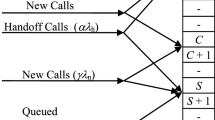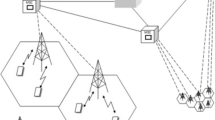Abstract
In this paper a new control-period-based distributed adaptive guard channel reservation (CDAGCR) technique is proposed to meet the call admission level quality-of-service (QoS) in wireless cellular networks. It partitions the real time into control periods. Handoffs during the current control period is used to reserve guard channels at the beginning of the next control period. Efficient mechanisms are devised to adaptively vary the length of the control period which further regulates the number of guard channels used to meet the call admission level QoS. The BSC associated with the cell site can do this exclusively without generating any signal overhead for information exchange among cell sites unlike the schemes described in [1–4]. Thus, the CDAGCR scheme is amenable to a fully distributed implementation. Extensive simulation studies have been carried out with an emulated test bed to investigate the performance of this CDAGCR scheme. It is found that this CDAGCR scheme keeps the handoff call drop probability below the targeted QoS with comparable new call blocking by adaptively varying the length of the control period. The simulation results appear promising.






















Similar content being viewed by others
References
Levine, D. A., Akyildiz, I. F., & Naghshineh, M. (1997). A resource estimation and call admission algorithm for wireless multimedia networks using the shadow cluster concept. IEEE/ACM Transactions on Networking, 5, 1–12.
Oliveira, C., Kim, J. B., & Suda, T. (1998). An adaptive bandwidth reservation scheme for high-speed multimedia wireless networks. IEEE JSAC, 16, 858–874.
Choi, S., & Shin, K. G. (2000). A comparative study of bandwidth reservation and admission control schemes in QoS-sensitive cellular networks. Wireless Networks, 6, 289–305.
Choi, S., & Shin, K. G. (2002). Adaptive bandwidth reservation and admission control in QoS-sensitive cellular networks. IEEE Transactions on Parallel and Distributed Systems, 13, 882–897.
Pati, H. K., Mall, R., & Sengupta, I. (2002). An efficient bandwidth reservation and call admission control scheme for wireless mobile networks. Elseviers’ Computer Communications, 25(1), 74–83.
Chiu, M-H., & Bassiouni, M. A. (2000). Predictive schemes for handoff prioritization in cellular networks based on mobile positioning. IEEE JSAC, 18, 510–522.
Choi, S., & Shin, K. G. (1998) Predictive and adaptive bandwidth reservation for hand-offs in QoS-sensitive cellular networks. ACM SIGCOMM’98, 155–166.
Katzela, I., & Naghshineh, M. (1996). Channel assignment schemes for cellular mobile telecommunication systems: A comprehensive survey. IEEE Personal Communications, 3, 10–31.
Naghshineh, M., & Schwartz, M. (1996) Distributed call admission control in mobile/wireless networks. IEEE JSAC, 14(4), 711–717.
Talukdar, A. K., Badrinath, B. R., & Acharya, A. (1999). Integrated services packet networks with mobile hosts: Architecture and performance. Wireless Networks, 5, 111–124.
Talukdar, A. K., Badrinath, B. R., & Acharya, A. (2001). MRSVP: A resource reservation protocol for an integrated services network with mobile hosts. Wireless Networks, 7, 5–19.
Boumerdassi, S., & Beylot, A. (1999). Adaptive channel allocation for wireless PCN. Mobile Networks and Applications, 4, 111–116.
Tekinay, S., & Jabbari, B. (1991). Handover and channel assignment in mobile cellular networks. IEEE Communications Magazine, 29, 42–46.
Lin, Y-B., Noerpel, A., & Harasty, D. (1994). A non-blocking channel assignment strategy for hand-offs. IEEE ICUPC, 558–562.
Cox, D., & Reudink, D. (1973). Increasing channel occupancy in large-scale mobile radio systems: Dynamic channel reassignment. IEEE Transactions on Communications, 21(11), 1302–1306.
Everitt, D., & Manfield, D. (1989). Performance analysis of cellular mobile communication systems with dynamic channel assignment. IEEE JSAC, 7, 1172–1180.
Falciasecca, G., Frullone, M., Riva, G., Sentinelli, M., & Serra, A. M. (1988). Investigation on a dynamic channel allocation for high capacity mobile radio systems. IEEE VTC, 176–181.
Hong, D., & Rappaport, S. S. (1986). Traffic model and performance analysis for cellular mobile radio telephone systems with prioritized and nonprioritized handoff procedures. IEEE Transactions on VT, VT-35, 77–92.
Oh, S-H., & Tcha, D-W. (1992). Prioritized channel assignment in a cellular radio network. IEEE Transactions on Communications, 40, 1259–1269.
Guérin, R. A. (1988). Queueing-blocking system with two arrival streams and guard channels. IEEE Transactions on Communications, 36, 153–163.
Yoon, C. H., & Un, C. K. (1993). Performance of personal portable radio telephone systems with and without guard channels. IEEE JSAC, 11, 911–917.
Lin, Y-B., Mohan, S., & Noerpel, A. (1994). PCS channel assignment strategies for handoff and initial access. 3rd Quarter of IEEE Personal Communications, 47–56.
Kulavaratharasah, M. D., & Aghvami, A. H. (1999). Teletraffic performance evaluation of microcellular personal communication networks (PCN’s) with prioritized handoff procedures. IEEE Transactions on VT, 48, 137–152.
Fantacci, R. (2000). Performance evaluation of prioritized handoff schemes in mobile cellular networks. IEEE Transactions on VT, 49, 485–493
Samanta, R. K., Bhattacharjee, P., & Sanyal, G. (2009). Performance analysis of cellular wireless network by queuing priority handoff calls. International Journal of Electrical and Electronics Engineering 3,(8) 472–477.
Tekinay, S., & Jabbari, B. (1992). A measurement-based prioritization scheme for handovers in mobile cellular networks. IEEE JSAC, 10, 1343–1350.
Ramjee, R., Towsley, D., & Nagarajan, R. (1997). On optimal call admission control in cellular networks. Wireless Networks, 3, 29–41.
Bartolini, N. (2001). Handoff and optimal channel assignment in wireless networks. Mobile Networks and Applications, 6, 511–524.
Panoutsopoulos, I. C., Kotsopoulos, S., & Tountopoulos, V. (2002). Handover and new call admission policy optimization for G3G systems. Wireless Networks, 8, 381–389.
Ho, C-J., & Lea, C-T. (1999). Improving call admission policies in wireless networks. Wireless Networks 5, 257–265.
Peha, J. M., & Stutivong, A. (2001). Admission control algorithms for cellular systems. Wireless Networks, 7, 117–125.
Yang, W-B., & Geraniotis, E. (1994). Admission policies for integrated voice and data traffic in CDMA packet radio networks. IEEE JSAC, 12(4), 654–664.
Naghshineh, M., & Acampora, A. S. (1995). QoS provisioning in micro-cellular networks supporting multimedia traffic. IEEE INFOCOM’95, 3, 1075–1084.
Tajima, J., & Imamura, K. (1988) A strategy for flexible channel assignment in mobile communication systems. IEEE Transactions on VT, 37(2), 92–103.
Jiang, S., Li, B., Luo, X., & Tsang, D. H. K. (2001). A modified distributed call admission control scheme and its performance. Wireless Networks, 7, 127–138.
Tian, X., & Ji, C. (2001). Bounding the performance of dynamic channel allocation with QoS provisioning for distributed admission control in wireless networks. IEEE Transactions on VT, 50, 388–397.
Li, B., Yin, L., Wong, K. Y. M., & Wu, S. (2001). An efficient and adaptive bandwidth allocation scheme for mobile wireless networks using an on-line local estimation technique. Wireless Networks, 7, 107–116.
Wu, S., Wong, K. Y. M., & Li, B. (2002). A dynamic call admission policy with precision QoS guarantee using stochastic control for mobile wireless networks. IEEE Transactions on Networking, 10, 257–271.
Ramanathan, P., Sivalingam, K. M., Agrawal, P., & Kishore, S. (1999). Dynamic resource allocation schemes during handoff for mobile multimedia wireless networks. IEEE JSAC, 17, 1270–1283.
Mišić, J., Chanson, S. T., & Lai, F. S. (1999). Admission control for multimedia networks with hard call level quality of service bounds. Elseviers Computer Networks, 31, 125–140.
Zhuang, W., Bensaou, B., & Chau, K. C. (2000). Adaptive quality of service handoff priority scheme for mobile multimedia networks. IEEE Transactions on VT, 49, 494–505.
Mišić, J., & Bun, T. Y. (2000). Adaptive admission control in wireless multimedia networks under nonuniform traffic conditions. IEEE JSAC, 18, 2429–2442.
Aljadhai, A. R., & Znati, T. F. (2001). Predictive mobility support for QoS provisioning in mobile wireless environments. IEEE JSAC, 19, 1915–1930.
Wang, J-L., & Chiang, S-Y. (2004). Adaptive channel assignment scheme for wireless networks. Computers and Electrical Engineering, 30, 417–426.
Beigy, H., & Meybodi, M. R. (2009). Adaptive limited fractional guard channel algorithms: A learning automata approach. International Journal of Uncertainty, Fuzziness and Knowledge-Based Systems, 17, 881–913.
Beigy, H., & Meybodi, M. R. (2011). Learning automata based dynamic guard channel algorithms. Computers and Electrical Engineering, 37, 601–613.
Zeng, H., & Chlamtac, I. (2003). Adaptive guard channel allocation and blocking probability estimation in PCS networks. Computer Networks, 43, 163–176.
Boumerdassi, S. (2000). An efficient reservation-based dynamic channel assignment strategy. 1st International conference on 3G mobile communication technologies, London, UK, pp. 352–355.
Jiang Y., & Bhargava, V. K. (1997). Mobility-oriented guard channel assignment for personal communication systems. IEEE ICPWC, 15–18.
Nelakuditi, S., Harinath, R. R., Rayadurgam, S., & Zhang, Z-L. (1999). Revenue-based call admission control for wireless cellular networks. IEEE ICPWC, 486–490.
Ortigoza-Guerrero, L., & Aghvami, A. H. (1999). A prioritized handoff dynamic channel allocation strategy for PCS. IEEE Transactions on VT, 48, 1203–1215.
Ruggieri, M., Gaincristofaro, D., Graziosi, F., & Santucci, F. (1995). An optimizable guard-channel-based handover procedure for mobile microcellular systems. IEEE PIMRC’95, 3, 1357–1361.
Pati, H. K. (2007). A distributed adaptive guard channel reservation scheme for cellular networks. Wileys’ International Journal of Communication Systems, 20, 1037–1058.
Fang, Y., Chlamtac, I., & Lin, Y-B. (1998). Channel occupancy times and handoff rate for mobile computing and PCS networks. IEEE Transactions on Computers, 47, 679–692.
Guérin, R. A. (1987). Channel occupancy time distribution in a cellular radio system. IEEE Transactions on VT, VT-35, 89–99.
Acknowledgments
The author is grateful for the constructive suggestions of the anonymous reviewers which has improved the content and the presentation.
Author information
Authors and Affiliations
Corresponding author
Rights and permissions
About this article
Cite this article
Pati, H.K. A control-period-based distributed adaptive guard channel reservation scheme for cellular networks. Wireless Netw 19, 1739–1753 (2013). https://doi.org/10.1007/s11276-013-0564-2
Published:
Issue Date:
DOI: https://doi.org/10.1007/s11276-013-0564-2




